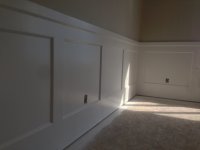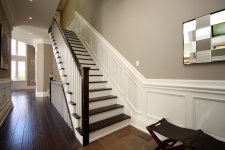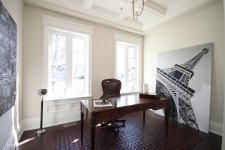I plan on wrapping the bottom ~40" of my basement walls in a shop made wainscoting. I wanted to get some ideas on MDF thickness. Not sure about the actual design yet ( maybe square edges on rails and styles). What thickness MDF do most use to rip down? At fist I thought 1/2, but then as I start to look at routed edges profile, and I don't think the 1/2 will be thick enough to show the profile properly, or am I wrong?
You are using an out of date browser. It may not display this or other websites correctly.
You should upgrade or use an alternative browser.
You should upgrade or use an alternative browser.
DIY MDF Wainscoting
- Thread starter Ben H
- Start date
leer
Member
- Joined
- Oct 4, 2013
- Messages
- 262
I am assuming the MDF would not extend down near the floor? We had a number of pieces of MDF kids furniture in our basement, and it flooded a few inches. Water heater burst, and the floor drain was clogged. [embarassed] The furniture swelled up like crazy, after being exposed just a few hours. Fortunately we had no drywall damage, and the pine baseboards and doors were fine.
tiralie
Member
- Joined
- Jan 26, 2010
- Messages
- 3,617
Ben H said:Not sure about the actual design yet ( maybe square edges on rails and styles). At fist I thought 1/2, but then as I start to look at routed edges profile, and I don't think the 1/2 will be thick enough to show the profile properly, or am I wrong?
I think you should figure out the design first. How big is your room? How tall are the walls? What kind of furniture are you putting in it? The design will dictate the requirements. For instance, are you going to have raised panels? If so, profiling the rails and stiles may be what you need to do and that will dictate the thickness of your edges and the thickness of the material you will need. Do you want a heavy shadow line or do you want a lighter look?
Ben H said:I wanted to get some ideas on MDF thickness. What thickness MDF do most use to rip down?
I think it depends on the design. I have used 5/8" with an applied bolection on this paneled built in.
Ben H said:I plan on wrapping the bottom ~40" of my basement walls in a shop made wainscoting.
You might want to check out this article on setting the chair rail/wainscoting height. Also read the comments, they are very good.
Tim
- Joined
- Jan 22, 2007
- Messages
- 8,426
This is a timely thread. I was thinking of doing some MDF wainscoting myself.
What do you do to tie the base back into the door casing since its 1/2" further out from the wall?
What do you do to tie the base back into the door casing since its 1/2" further out from the wall?
tiralie
Member
- Joined
- Jan 26, 2010
- Messages
- 3,617
Shane Holland said:This is a timely thread. I was thinking of doing some MDF wainscoting myself.
What do you do to tie the base back into the door casing since its 1/2" further out from the wall?
Shane:
If you are referring to the door casing being thinner than the wainscoting stiles and rails then I would use a back band. If your casing doesn't suit a back band, remove the casing and either replace it with a thicker profile or build it out so it projects slightly above the wainscoting.
Others may have a different approach.
Tim
I forgot to mention that the article linked above also discusses terminating the chair rail but I also think this article on planning your panel spacing is also very good.
I was thinking, although I didn't say in my OP, a shaker style roughly on 24" spacing for panels. 4-6" stiles, and a 8" base. The room is one large "U" shaped room. Roughly 200 LF to do. 8ft ceilings. These are all rough numbers that I've seen off the net.
I was also planing on removing the stock crappy door casing and just wrap the door with e MDF to keep the look the same. Is this a bad idea?
I was also planing on removing the stock crappy door casing and just wrap the door with e MDF to keep the look the same. Is this a bad idea?
- Joined
- Jul 8, 2007
- Messages
- 13,126
Shane,
If you are talking about the base molding, you can instead of backhand shorten the casing and install plinths - even home-made using some of your green tools.
Peter
If you are talking about the base molding, you can instead of backhand shorten the casing and install plinths - even home-made using some of your green tools.
Peter
Saskataper
Member
- Joined
- Jan 27, 2013
- Messages
- 278
CarolinaNomad
Member
- Joined
- Sep 17, 2010
- Messages
- 307
Saskataper
Member
- Joined
- Jan 27, 2013
- Messages
- 278
Nice work!!
I love the the wainscoting under the windows, just adds that little touch of class without overdoing it in a small room.
I love the the wainscoting under the windows, just adds that little touch of class without overdoing it in a small room.
CarolinaNomad
Member
- Joined
- Sep 17, 2010
- Messages
- 307
One technique I recommend from Gary Stiegler's Articles is to pocket screw and glue the rails and stiles. Slightly, wipe off the excess glue on the front side and then sand the joint while the glue is tacky. Basically, build 8 feet of face frames and nail to wall. This is where mdf shines. With the ease of sanding fine dust, you can easily fill the joint in right then and there and reduce prep time at painting.
The other technique, is to just nail the stiles and rails independently of each other to the drywall and just glue the joint. It will fail, there will be one or two joints that will move and separate due to movement of the house.
The other technique, is to just nail the stiles and rails independently of each other to the drywall and just glue the joint. It will fail, there will be one or two joints that will move and separate due to movement of the house.
FlobeySolo
Member
- Joined
- Jul 22, 2013
- Messages
- 30
Hi - finished paneling our dining room in December with 1/4" masonite and 1/2" MDF rails and stiles (pics: here). Most of the joints were pocket hole screws like a face frame, however they got too big and unwieldly to assemble a whole wall at a time, so some of the joints are glued with no screws...and they've opened up a bit. I built out the door casing so it sits a bit proud of the base molding...not sure if that was the right way to do it, but it looked better to my eyes than any other alternative I could think of.
Other than the layout, the biggest challenge I had was sanding all the edges of MDF to get rid of the rough finish when it's cut. It was a real pain, although the pros may know a trick or two....
Other than the layout, the biggest challenge I had was sanding all the edges of MDF to get rid of the rough finish when it's cut. It was a real pain, although the pros may know a trick or two....
WarrenWeldon
Member
- Joined
- Mar 16, 2014
- Messages
- 26
I have to say this is beautiful and the look I am after. I am absolutely stunned by the section under the desk! Is it a build up wood section, a woven piece ,,,? It is incredible!CarolinaNomad said:[attachimg=#]
1/2" mdf with raised panel moulding
[attachimg=#]
1/2" mdf with 1/4" cove.
Gary Striegler on Fine Homebuilding has some great articles on wainscotting
- Joined
- Apr 13, 2011
- Messages
- 4,550
Hi Ben
I usually use 12mm MDF for the raised field and 19mm for the frames.
I hope this video helps helps.
Peter
I usually use 12mm MDF for the raised field and 19mm for the frames.
I hope this video helps helps.
Peter
CarolinaNomad
Member
- Joined
- Sep 17, 2010
- Messages
- 307
WarrenWeldon said:I have to say this is beautiful and the look I am after. I am absolutely stunned by the section under the desk! Is it a build up wood section, a woven piece ,,,? It is incredible!CarolinaNomad said:[attachimg=#]
1/2" mdf with raised panel moulding
[attachimg=#]
1/2" mdf with 1/4" cove.
Gary Striegler on Fine Homebuilding has some great articles on wainscotting
The woven piece under the desk is a leather rug.
Not to dig up an old thread but as a new member I stumbled across this thread as I was getting ready to install wainscoting in our son's room.
I was basically going to to with a fairly simplistic flat panel design and maybe trim up the panels with quarter round or a cove. I initially was going to rout all the stiles and rails with a round over but decided just installing the quarter round would be easier and quicker. Although it looks like the one picture in this thread has a flat panel design with chamfered edges, which looks intriguing.
The original plan was install 1/8" or 1/4" hardboard/masonite to the walls (the drywall isn't perfectly smooth as previous owners did a horrible job painting, etc) and then 3/4" rails and stiles from either ripped mdf or pre-fabbed/primed mdf or pine (if I get lazy and want to pay extra!). But now I am thinking maybe 1/2" mdf or pine with either a routed edge or 1/4" quarter round would be better as to not give as deep a look to the panels. The other issue is what to do around the doors and windows. I initially wanted the stiles and rails to flow into the casings as if everything is one continous mix of stiles, rails, casing. But if I install a masonite backing, it's going to raise the wainscoting and it won't flow smoothly (or flush) with the casings. I then thought about maybe a simple square backband (I am trying to keep the overall look fairly clean and almost craftsman-like) to raise the edge of the casing to give it a clean looking break.
Sorry for the rambling. Any suggestions?
I was basically going to to with a fairly simplistic flat panel design and maybe trim up the panels with quarter round or a cove. I initially was going to rout all the stiles and rails with a round over but decided just installing the quarter round would be easier and quicker. Although it looks like the one picture in this thread has a flat panel design with chamfered edges, which looks intriguing.
The original plan was install 1/8" or 1/4" hardboard/masonite to the walls (the drywall isn't perfectly smooth as previous owners did a horrible job painting, etc) and then 3/4" rails and stiles from either ripped mdf or pre-fabbed/primed mdf or pine (if I get lazy and want to pay extra!). But now I am thinking maybe 1/2" mdf or pine with either a routed edge or 1/4" quarter round would be better as to not give as deep a look to the panels. The other issue is what to do around the doors and windows. I initially wanted the stiles and rails to flow into the casings as if everything is one continous mix of stiles, rails, casing. But if I install a masonite backing, it's going to raise the wainscoting and it won't flow smoothly (or flush) with the casings. I then thought about maybe a simple square backband (I am trying to keep the overall look fairly clean and almost craftsman-like) to raise the edge of the casing to give it a clean looking break.
Sorry for the rambling. Any suggestions?
Similar threads
- Replies
- 24
- Views
- 1K
- Replies
- 0
- Views
- 227
- Replies
- 4
- Views
- 290



